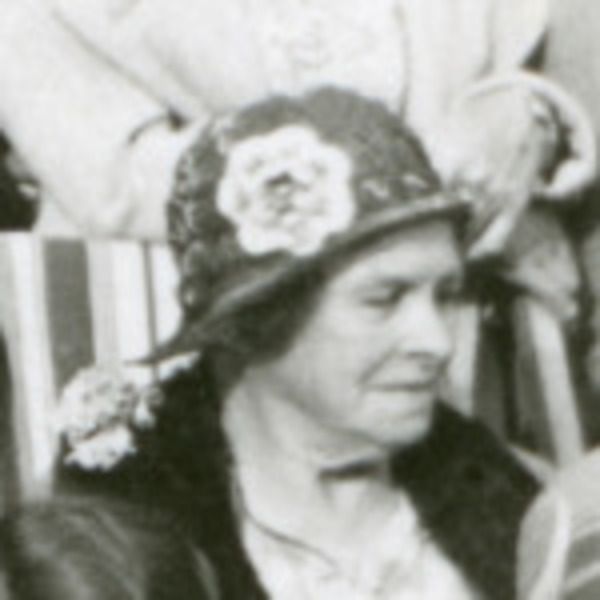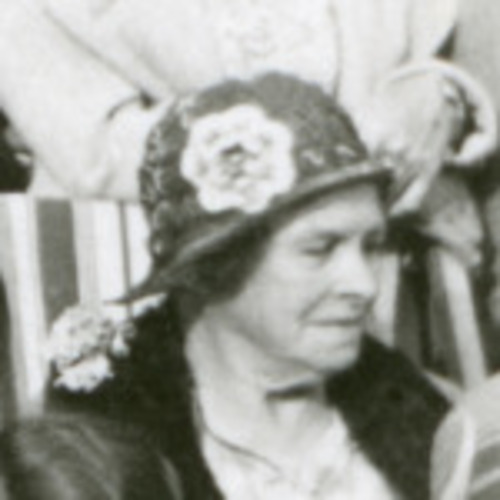
Source: Link
McALISTER (Macalister), ELIZA (Elsie) (Cassels), naturalist, farmer, and office holder; b. 16 Feb. 1864 in the Megget portion of the parish of Lyne and Megget, Scotland, daughter of Archibald McAlister and Janet Reid; m. 5 April 1889 William Anderson Cassels (1864–1941) in Cappercleuch, Scotland; they had no children; d. 12 Nov. 1938 in Red Deer, Alta.
Elsie McAlister’s father was a Free Church schoolmaster who seems to have provided his daughter with a classical education, and her marriage ceremony was performed in the family home, the Free Church schoolhouse, by one of the McAlisters’ lodgers, who used a simple sheriff’s warrant. Her husband, William, had been born in Yorkshire, England, of Scottish parents and had attended Edinburgh Academy, a private secondary school. His father was a vicar in the Church of England, and acquaintances believed that William’s marriage so displeased his parents, perhaps on religious grounds, that the young couple were banished to Canada and, for the rest of their lives, relied on remittances from home. The truth is different. William had been living in the American west for many years when he met Elsie, and he had returned to Scotland with the express purpose of finding a wife to join him in farming on the North American plains. He also did not fit the stereotype of the remittance man. Far from depending on cash infusions from home, he gradually amassed a small fortune in real-estate holdings in Alberta and even underwrote other people’s mortgages, though he was miserly in the treatment of his own wife.
Elsie and William started out as homesteaders in 1889 near Penhold, Alta. When this property failed on account of a lack of water, they moved to the Clearview district. By 1895 they had broken 11 acres of prairie, built 2 miles of fencing for livestock, and converted their sod-house to brick. They were finally granted title to their land in 1897. Neighbours believed that the Cassels were poverty-stricken – it was said that they looked “half-starved” most of the time – even though they had “good horses” and “good guns.” According to an interview given by Elsie and printed in the local paper, “their meager provisions and lack of warm clothing in the winter” wore them down. Fortunately for Elsie, they would not live out their lives as isolated subsistence farmers but instead relocated to Red Deer in 1902. Their decision to give up farming may have stemmed in part from their lack of children, a serious handicap since child labour was needed to help expand farms.
Interest in natural history was widespread in the Scotland of Elsie’s youth – the study of nature was seen as the route to self-improvement for the individual and to the betterment of society as a whole – and she herself was drawn to the subject at an early age. Nor did the attraction fade with time; on the contrary, Elsie remained an avid naturalist throughout her life. After moving to Red Deer, she began collaborating with other local naturalists, such as Francis (Frank) La Grange Farley, Thomas Edmund Randall, and Charles Snell. She took an active role in the Alberta Natural History Society (ANHS), joining the group in 1906, its inaugural year, when she was 42, and at the same time campaigned for the creation of a provincial park to encompass the Red Deer River canyon. She failed in this endeavour, but in 1924 she succeeded in having the Gaetz Lake Sanctuary created as a dominion wildlife refuge, where she later served as a game officer for the dominion parks branch of the Canada Bird Protection Service. The ANHS’s founding president, Henry George, was a British physician keenly interested in birds, and he and Elsie Cassels directed the organization together from 1916 to 1922. Elsie served as its vice-president from 1917 to 1924, the first woman to hold an official position in any natural-history society in Canada.
At a time when government had little expertise or institutional capacity in environmental matters, amateur scientists and societies like the ANHS were critical both in preserving the country’s wildlife and natural landscape and in educating the public on the necessity of such work. Even so, there were divisions among naturalists. It was widely known, for example, that Cassels and George were constantly at odds over taxonomy and identification. Unlike more traditional conservationists, such as George and James Henry Fleming, Elsie firmly argued against shooting birds for natural-history collections; instead, she lectured to members of other naturalist groups on the importance of patient observation with the use of binoculars and the recognition of unique bird songs. In contrast, George had no qualms about shooting rare birds and removing their eggs for his own collections, believing that the true proof of identification lay in examination and dissection. Elsie’s emphasis on field observation, rather than collecting, foreshadowed the future direction of ornithological study, but, in her own time, her influence in Alberta naturalist circles would not emerge until after George’s retirement in 1922.
Elsie Cassels’s field studies ranged from the Red Deer River to Sylvan Lake, where William had acquired 33 acres of shoreline property. There, from a home called the Ark, she established purple martin colonies and undertook research on several species, including the pygmy nuthatch, Hudsonian chickadee, jaeger, white gyrfalcon, rufous hummingbird, and red-breasted nuthatch. As her reputation for accuracy grew, she began corresponding with some well-known ornithologists, such as William Robert Rowan and Percy Algernon Taverner. They encouraged her to submit her observations to the Canadian Field-Naturalist, which she did from 1920 to 1937. The letters between Cassels and Rowan, Taverner, Farley, Randall, and Snell reveal a woman who was much respected for her opinions and methods. She was the person mainly responsible for the ANHS’s migratory bird count, a widely circulated document that assisted in Rowan’s scientific work at the University of Alberta.
A resourceful woman – she often said she wished she had been a carpenter – Elsie Cassels was not intimidated by the challenges of prairie farming. She also had an unconventional streak, illustrated by her smoking of cigarettes – a somewhat scandalous proclivity for a woman at the time. Known for her “charm and culture,” she had a lovely singing voice and was a self-taught violinist. Above all, she felt deeply about the birds she studied, writing in the Red Deer Advocate in 1921 that “I know of no prettier sight than a flock of Redwings flying back and forth over their nesting grounds in the morning sunlight, trilling their lovely call note, and spreading their scarlet wings to show the gorgeous scarlet and cream-edged shoulder patch as they hover over the nest.” Towards the end of Elsie’s life, a friend wrote: “For a good number of years, her time has been much in demand as a bird lecturer, and as she explains their habits and their peculiarities, her face lights up with enthusiasm, and her audience is carried away from the realities of the present, and in imagination lives among the birds and the beauties of nature.”
Elsie Cassels is said to have long suffered from heart trouble, and her death in 1938 was likely the result of a stroke. She predeceased William by three years. While Elsie was much admired in Red Deer and participated in many social events, William remained aloof and reserved; according to rumour he often had fits of depression during which he would not speak to anyone for weeks. After he died the local newspaper carried a story that claimed his estate was worth $90,000, all of which was sent back to a distant relative in Scotland. One of the ironies of the couple’s life together was that they lived frugally, skimping on firewood, food, and clothing, and occasionally not paying ANHS or church dues. The community was shocked that a talented and cheerful woman such as Elsie, who had broken in a prairie homestead and actively pursued an interest in nature, could have accomplished so much with so little support. Had it not been for her energy and enthusiasm in studying natural history based on a new approach to fieldwork, her name would have remained obscure.
Eliza McAlister (Cassels) was a contributor to the “Notes and observations” column in the Canadian Field-Naturalist (Ottawa). Her contributions include: “Hudsonian chickadee,” 34 (1920): 99; “The jaeger at Sylvan Lake, Alta,” 34 (1920): 159; “White gyrfalcon in Alberta,” 36 (1922): 58; “Rufous hummingbird,” 42 (1928): 150; “Red-breasted nuthatch,” 49 (1935): 140; and “Unusual nesting of eastern redwings,” 51 (1937): 12. She is also the author of a newspaper article, “Our familiar birds,” Red Deer Advocate (Red Deer, Alta), 15 July 1921: 7, and a letter to the editor of the Canadian Field-Naturalist, 38 (1924): 34.
Ancestry.com, “1861 Scotland census”; “1871 Scotland census”; and “1881 Scotland census”: www.ancestry.ca (consulted 9 Nov. 2016). LAC, R233-36-4, Northwest Territories, dist. Alberta (197), subdist. Calgary and Red Deer (A): 2, 3; R233-37-6, Territories, dist. Alberta (202), subdist. Red Deer (Y3): 4; R233-46-7, Alberta, dist. Strathcona (21), subdist. Town of Red Deer (44): 21. NRS, SR Marriages, Megget (Peeblesshire), 5 April 1889. Red Deer & Dist. Arch. (Alta), MG31/184 (Red Deer River Naturalist fonds), minutes (1908–21) and annual reports (1910–21). M. P. Cole, “History of Springvale: Mr. and Mrs. Cassels,” Red Deer Advocate, 13 Feb. 1959: sect.2, p.1. A. L. Gaetz, “Woman provides sanctuary for feathered folk,” Calgary Daily Herald, 13 April 1935: 31. “Many attend services for Mrs Cassels,” Albertan (Calgary), 18 Nov. 1938: 11. “Many brave women pioneers of the Red Deer district,” Red Deer Advocate, 18 July 1934: sect.3, p.1. “Pioneers of central Alberta,” Red Deer Advocate, 18 March 1967: 5. M. G. Ainley, Restless energy: a biography of William Rowan, 1891–1957 (Montreal, 1992). J. L. Cranmer-Byng, “A life with birds: Percy A. Taverner, Canadian ornithologist, 1875–1947,” Canadian Field-Naturalist, 110 (1996): 1–254. Ernestine Crossfield, “A natural adaptation: Elsie (McAlister) Cassels: Scottish immigrant and naturalist on the Albertan prairie, 1889–1938” (ma thesis, Concordia Univ., Montreal, 1997). D. A. Finnegan, “Natural history societies in late Victorian Scotland and the pursuit of local civic science,” British Journal for the Hist. of Science (Cambridge, Eng.), 38 (2005): 53–72. J. M. MacKenzie, Museums and empire: natural history, human cultures and colonial identities (Manchester, Eng., and New York, 2009). “Obituary notice,” Canadian Field-Naturalist, 53 (1939): 29.
Cite This Article
E. Tina Crossfield, “McALISTER (Macalister), ELIZA (Elsie) (Cassels),” in Dictionary of Canadian Biography, vol. 16, University of Toronto/Université Laval, 2003–, accessed December 29, 2025, https://www.biographi.ca/en/bio/mcalister_eliza_16E.html.
The citation above shows the format for footnotes and endnotes according to the Chicago manual of style (16th edition). Information to be used in other citation formats:
| Permalink: | https://www.biographi.ca/en/bio/mcalister_eliza_16E.html |
| Author of Article: | E. Tina Crossfield |
| Title of Article: | McALISTER (Macalister), ELIZA (Elsie) (Cassels) |
| Publication Name: | Dictionary of Canadian Biography, vol. 16 |
| Publisher: | University of Toronto/Université Laval |
| Year of publication: | 2020 |
| Year of revision: | 2020 |
| Access Date: | December 29, 2025 |



